Eating Behavior in UK Adolescents
VerifiedAdded on 2019/12/03
|32
|9349
|238
Report
AI Summary
This comprehensive report investigates the factors influencing eating behavior among adolescents in the UK. It employs a mixed-methods approach, incorporating both qualitative and quantitative data collection and analysis. The report begins by outlining the research process, including the selection of the research topic, the purpose and outline of the research, a preliminary literature review, and a detailed explanation of the chosen research methodology. A Gantt chart is included to illustrate the research plan. The main body of the report presents a thorough literature review, discussing the impacts of eating behavior, both positive and negative, and identifying various influencing factors such as age, income, race, personal factors, economic factors, and environmental factors. The primary research involved a questionnaire survey administered to parents of adolescents in London, UK. The data analysis section utilizes both thematic analysis and statistical analysis (cross-tabulation and chi-square test) to interpret the findings. The report concludes with recommendations for improving adolescent eating habits and suggests areas for future research, such as expanding the geographical scope, investigating the impacts of eating behavior in different age groups, and exploring the role of biological factors and other external influences.

TO ANALYZE THE FACTORS INFLUENCING
EATING BEHAVIOR IN ADOLESCENT
POPULATION IN THE UK
EATING BEHAVIOR IN ADOLESCENT
POPULATION IN THE UK
Paraphrase This Document
Need a fresh take? Get an instant paraphrase of this document with our AI Paraphraser
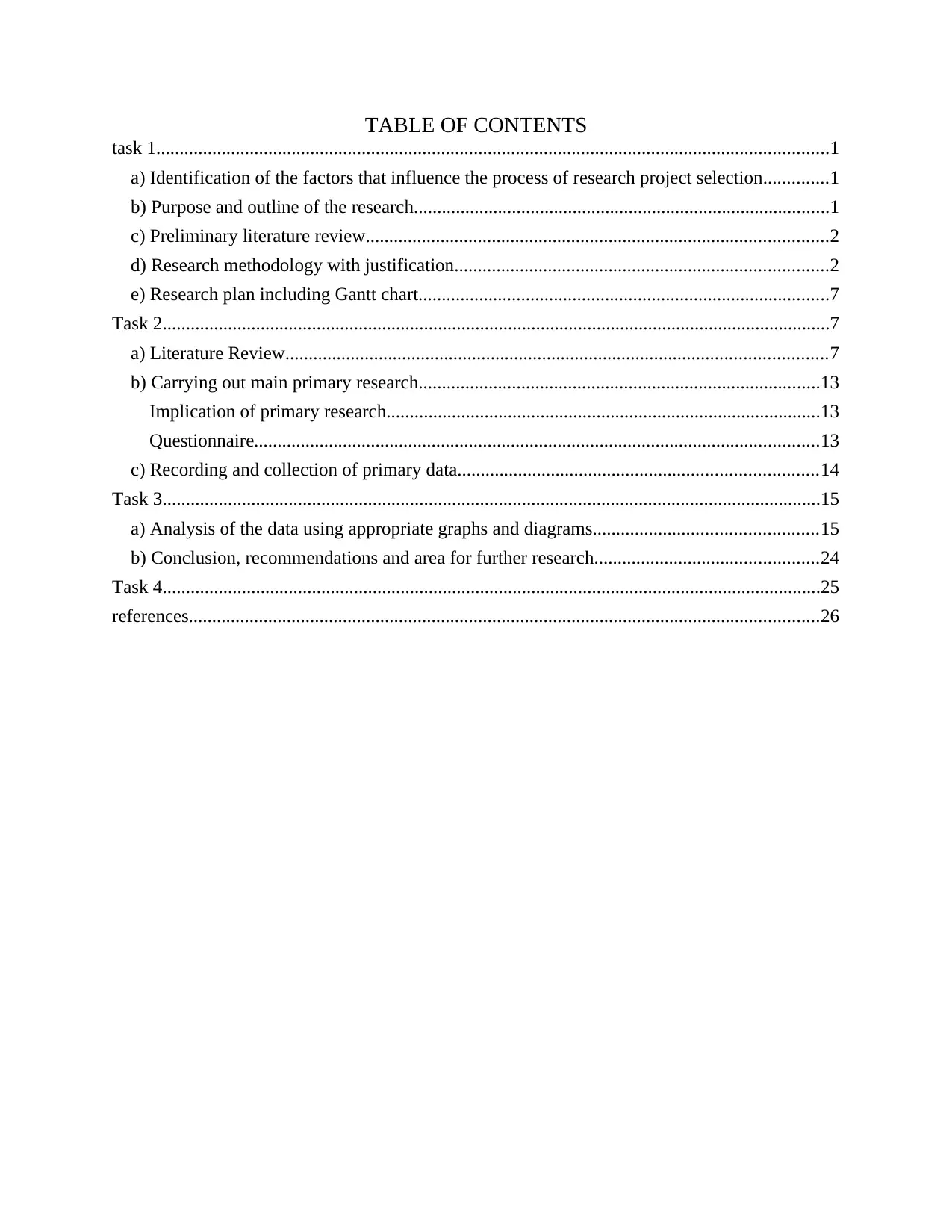
TABLE OF CONTENTS
task 1................................................................................................................................................1
a) Identification of the factors that influence the process of research project selection..............1
b) Purpose and outline of the research.........................................................................................1
c) Preliminary literature review...................................................................................................2
d) Research methodology with justification................................................................................2
e) Research plan including Gantt chart........................................................................................7
Task 2...............................................................................................................................................7
a) Literature Review....................................................................................................................7
b) Carrying out main primary research......................................................................................13
Implication of primary research.............................................................................................13
Questionnaire.........................................................................................................................13
c) Recording and collection of primary data.............................................................................14
Task 3.............................................................................................................................................15
a) Analysis of the data using appropriate graphs and diagrams................................................15
b) Conclusion, recommendations and area for further research................................................24
Task 4.............................................................................................................................................25
references.......................................................................................................................................26
task 1................................................................................................................................................1
a) Identification of the factors that influence the process of research project selection..............1
b) Purpose and outline of the research.........................................................................................1
c) Preliminary literature review...................................................................................................2
d) Research methodology with justification................................................................................2
e) Research plan including Gantt chart........................................................................................7
Task 2...............................................................................................................................................7
a) Literature Review....................................................................................................................7
b) Carrying out main primary research......................................................................................13
Implication of primary research.............................................................................................13
Questionnaire.........................................................................................................................13
c) Recording and collection of primary data.............................................................................14
Task 3.............................................................................................................................................15
a) Analysis of the data using appropriate graphs and diagrams................................................15
b) Conclusion, recommendations and area for further research................................................24
Task 4.............................................................................................................................................25
references.......................................................................................................................................26

LIST OF TABLES
Table 1: Gantt chart.........................................................................................................................7
Table 1: Gantt chart.........................................................................................................................7
⊘ This is a preview!⊘
Do you want full access?
Subscribe today to unlock all pages.

Trusted by 1+ million students worldwide
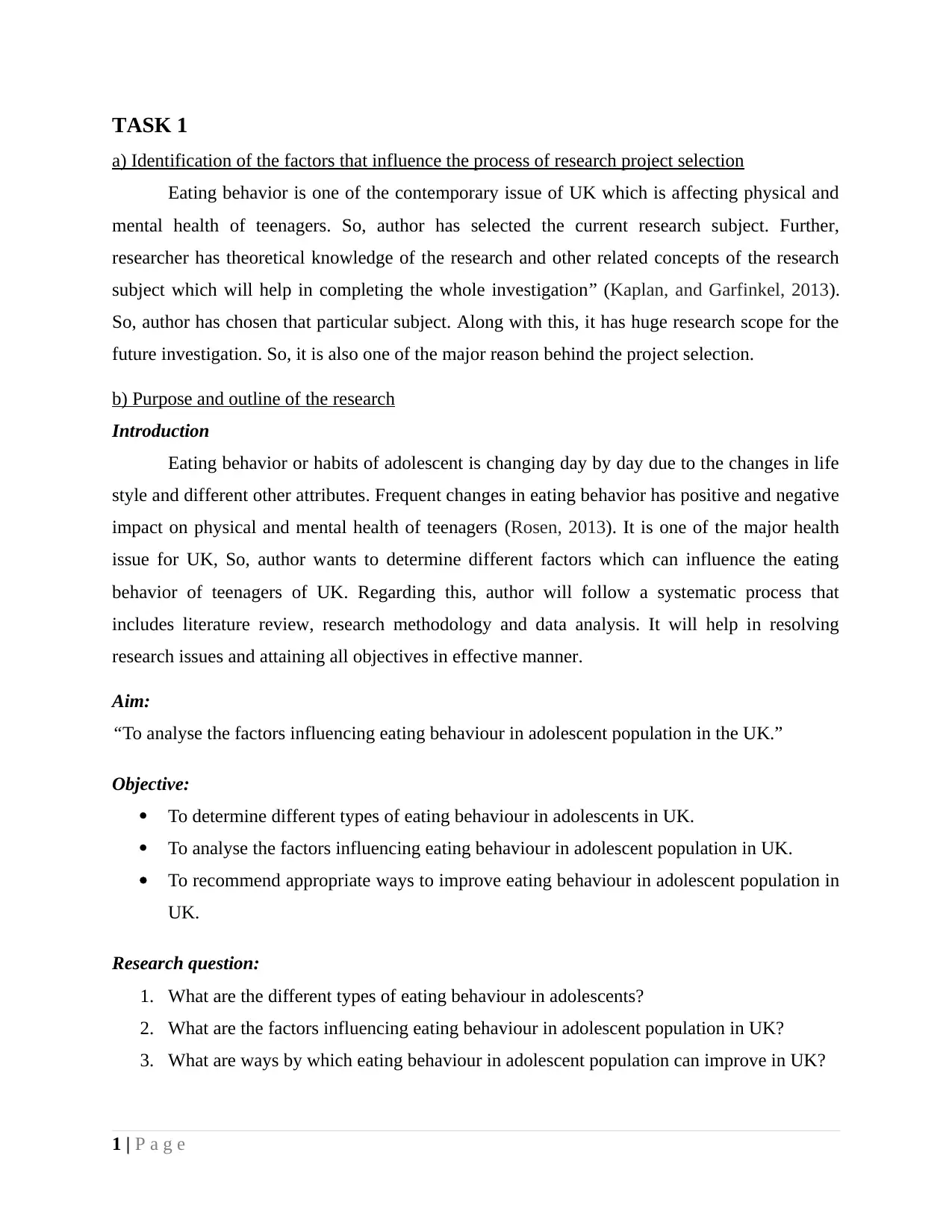
TASK 1
a) Identification of the factors that influence the process of research project selection
Eating behavior is one of the contemporary issue of UK which is affecting physical and
mental health of teenagers. So, author has selected the current research subject. Further,
researcher has theoretical knowledge of the research and other related concepts of the research
subject which will help in completing the whole investigation” (Kaplan, and Garfinkel, 2013).
So, author has chosen that particular subject. Along with this, it has huge research scope for the
future investigation. So, it is also one of the major reason behind the project selection.
b) Purpose and outline of the research
Introduction
Eating behavior or habits of adolescent is changing day by day due to the changes in life
style and different other attributes. Frequent changes in eating behavior has positive and negative
impact on physical and mental health of teenagers (Rosen, 2013). It is one of the major health
issue for UK, So, author wants to determine different factors which can influence the eating
behavior of teenagers of UK. Regarding this, author will follow a systematic process that
includes literature review, research methodology and data analysis. It will help in resolving
research issues and attaining all objectives in effective manner.
Aim:
“To analyse the factors influencing eating behaviour in adolescent population in the UK.”
Objective:
To determine different types of eating behaviour in adolescents in UK.
To analyse the factors influencing eating behaviour in adolescent population in UK.
To recommend appropriate ways to improve eating behaviour in adolescent population in
UK.
Research question:
1. What are the different types of eating behaviour in adolescents?
2. What are the factors influencing eating behaviour in adolescent population in UK?
3. What are ways by which eating behaviour in adolescent population can improve in UK?
1 | P a g e
a) Identification of the factors that influence the process of research project selection
Eating behavior is one of the contemporary issue of UK which is affecting physical and
mental health of teenagers. So, author has selected the current research subject. Further,
researcher has theoretical knowledge of the research and other related concepts of the research
subject which will help in completing the whole investigation” (Kaplan, and Garfinkel, 2013).
So, author has chosen that particular subject. Along with this, it has huge research scope for the
future investigation. So, it is also one of the major reason behind the project selection.
b) Purpose and outline of the research
Introduction
Eating behavior or habits of adolescent is changing day by day due to the changes in life
style and different other attributes. Frequent changes in eating behavior has positive and negative
impact on physical and mental health of teenagers (Rosen, 2013). It is one of the major health
issue for UK, So, author wants to determine different factors which can influence the eating
behavior of teenagers of UK. Regarding this, author will follow a systematic process that
includes literature review, research methodology and data analysis. It will help in resolving
research issues and attaining all objectives in effective manner.
Aim:
“To analyse the factors influencing eating behaviour in adolescent population in the UK.”
Objective:
To determine different types of eating behaviour in adolescents in UK.
To analyse the factors influencing eating behaviour in adolescent population in UK.
To recommend appropriate ways to improve eating behaviour in adolescent population in
UK.
Research question:
1. What are the different types of eating behaviour in adolescents?
2. What are the factors influencing eating behaviour in adolescent population in UK?
3. What are ways by which eating behaviour in adolescent population can improve in UK?
1 | P a g e
Paraphrase This Document
Need a fresh take? Get an instant paraphrase of this document with our AI Paraphraser
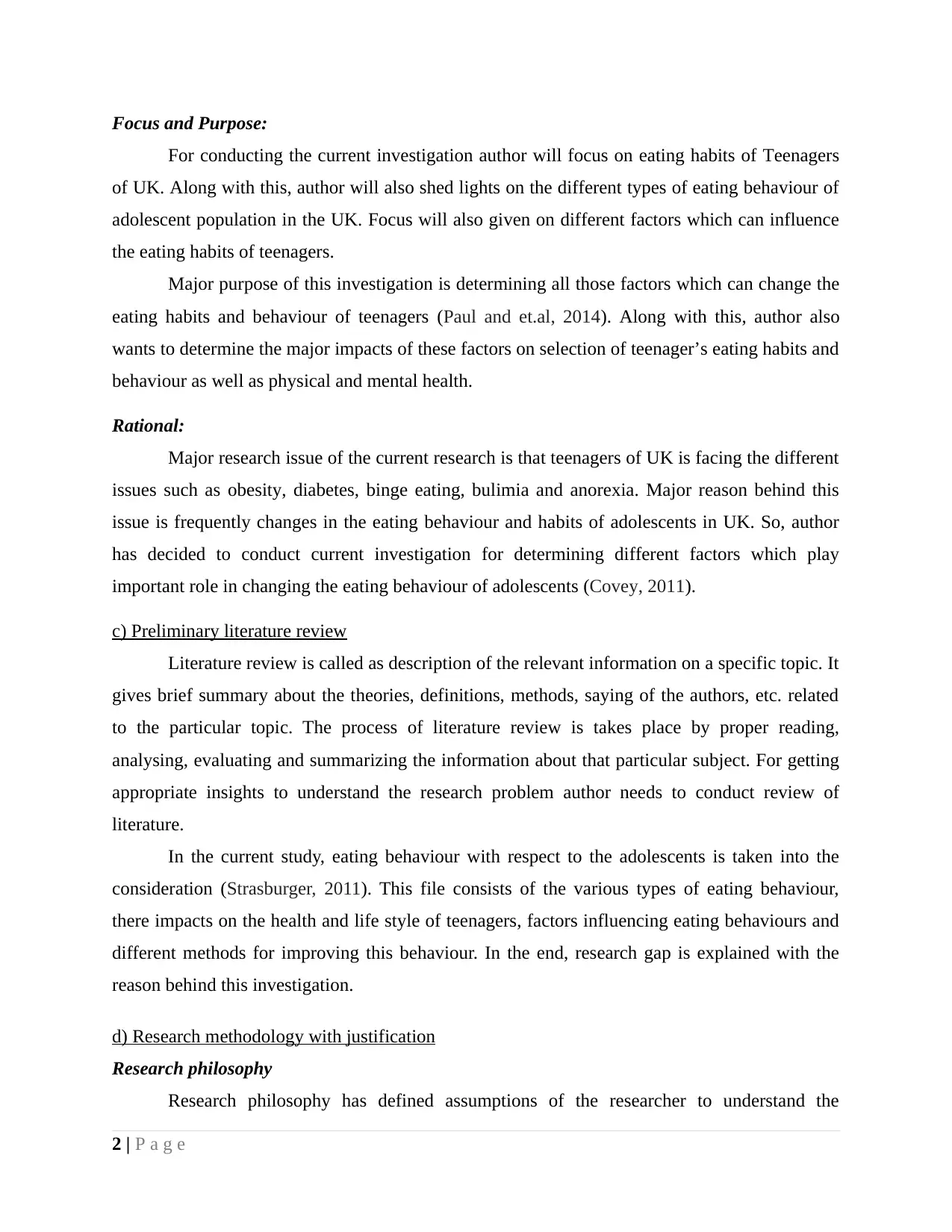
Focus and Purpose:
For conducting the current investigation author will focus on eating habits of Teenagers
of UK. Along with this, author will also shed lights on the different types of eating behaviour of
adolescent population in the UK. Focus will also given on different factors which can influence
the eating habits of teenagers.
Major purpose of this investigation is determining all those factors which can change the
eating habits and behaviour of teenagers (Paul and et.al, 2014). Along with this, author also
wants to determine the major impacts of these factors on selection of teenager’s eating habits and
behaviour as well as physical and mental health.
Rational:
Major research issue of the current research is that teenagers of UK is facing the different
issues such as obesity, diabetes, binge eating, bulimia and anorexia. Major reason behind this
issue is frequently changes in the eating behaviour and habits of adolescents in UK. So, author
has decided to conduct current investigation for determining different factors which play
important role in changing the eating behaviour of adolescents (Covey, 2011).
c) Preliminary literature review
Literature review is called as description of the relevant information on a specific topic. It
gives brief summary about the theories, definitions, methods, saying of the authors, etc. related
to the particular topic. The process of literature review is takes place by proper reading,
analysing, evaluating and summarizing the information about that particular subject. For getting
appropriate insights to understand the research problem author needs to conduct review of
literature.
In the current study, eating behaviour with respect to the adolescents is taken into the
consideration (Strasburger, 2011). This file consists of the various types of eating behaviour,
there impacts on the health and life style of teenagers, factors influencing eating behaviours and
different methods for improving this behaviour. In the end, research gap is explained with the
reason behind this investigation.
d) Research methodology with justification
Research philosophy
Research philosophy has defined assumptions of the researcher to understand the
2 | P a g e
For conducting the current investigation author will focus on eating habits of Teenagers
of UK. Along with this, author will also shed lights on the different types of eating behaviour of
adolescent population in the UK. Focus will also given on different factors which can influence
the eating habits of teenagers.
Major purpose of this investigation is determining all those factors which can change the
eating habits and behaviour of teenagers (Paul and et.al, 2014). Along with this, author also
wants to determine the major impacts of these factors on selection of teenager’s eating habits and
behaviour as well as physical and mental health.
Rational:
Major research issue of the current research is that teenagers of UK is facing the different
issues such as obesity, diabetes, binge eating, bulimia and anorexia. Major reason behind this
issue is frequently changes in the eating behaviour and habits of adolescents in UK. So, author
has decided to conduct current investigation for determining different factors which play
important role in changing the eating behaviour of adolescents (Covey, 2011).
c) Preliminary literature review
Literature review is called as description of the relevant information on a specific topic. It
gives brief summary about the theories, definitions, methods, saying of the authors, etc. related
to the particular topic. The process of literature review is takes place by proper reading,
analysing, evaluating and summarizing the information about that particular subject. For getting
appropriate insights to understand the research problem author needs to conduct review of
literature.
In the current study, eating behaviour with respect to the adolescents is taken into the
consideration (Strasburger, 2011). This file consists of the various types of eating behaviour,
there impacts on the health and life style of teenagers, factors influencing eating behaviours and
different methods for improving this behaviour. In the end, research gap is explained with the
reason behind this investigation.
d) Research methodology with justification
Research philosophy
Research philosophy has defined assumptions of the researcher to understand the
2 | P a g e
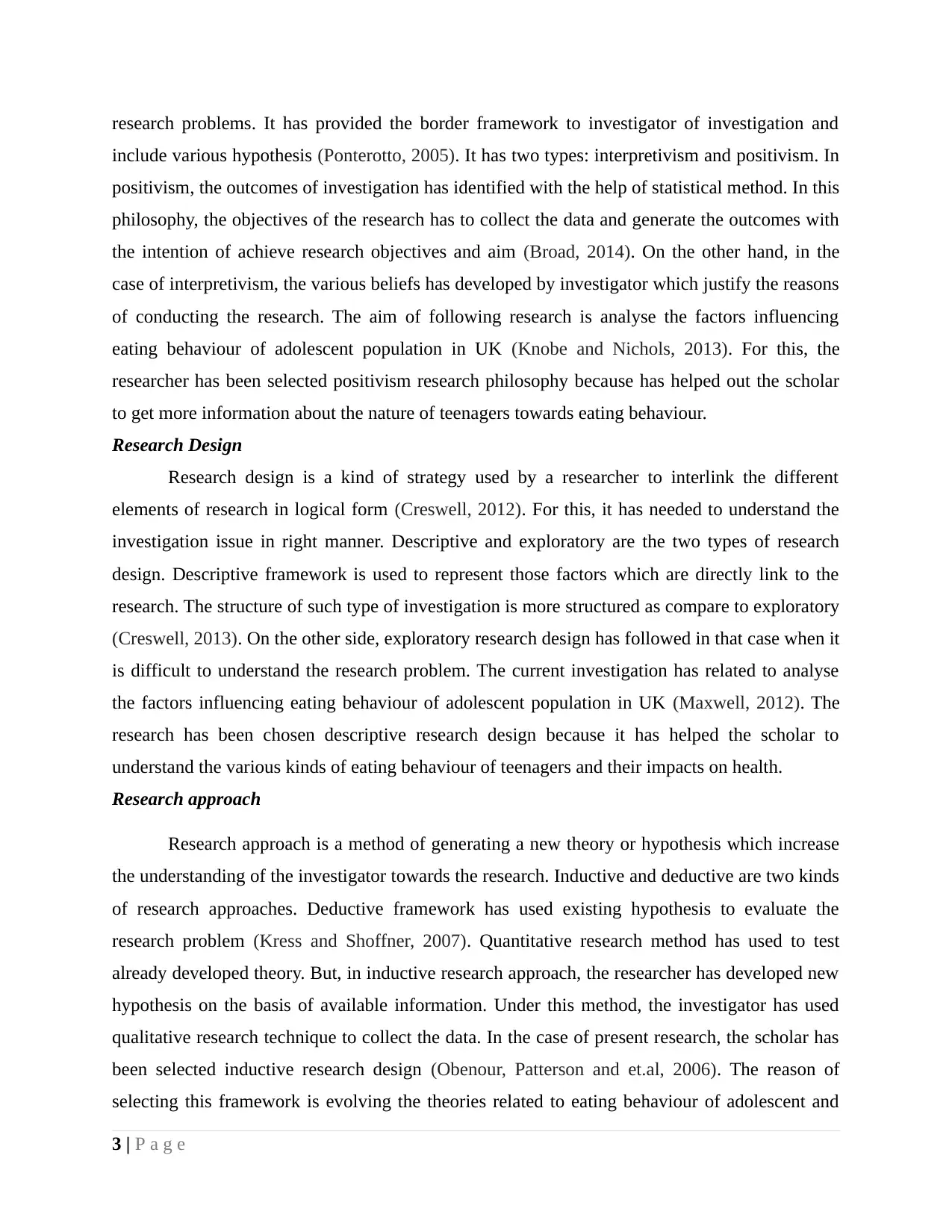
research problems. It has provided the border framework to investigator of investigation and
include various hypothesis (Ponterotto, 2005). It has two types: interpretivism and positivism. In
positivism, the outcomes of investigation has identified with the help of statistical method. In this
philosophy, the objectives of the research has to collect the data and generate the outcomes with
the intention of achieve research objectives and aim (Broad, 2014). On the other hand, in the
case of interpretivism, the various beliefs has developed by investigator which justify the reasons
of conducting the research. The aim of following research is analyse the factors influencing
eating behaviour of adolescent population in UK (Knobe and Nichols, 2013). For this, the
researcher has been selected positivism research philosophy because has helped out the scholar
to get more information about the nature of teenagers towards eating behaviour.
Research Design
Research design is a kind of strategy used by a researcher to interlink the different
elements of research in logical form (Creswell, 2012). For this, it has needed to understand the
investigation issue in right manner. Descriptive and exploratory are the two types of research
design. Descriptive framework is used to represent those factors which are directly link to the
research. The structure of such type of investigation is more structured as compare to exploratory
(Creswell, 2013). On the other side, exploratory research design has followed in that case when it
is difficult to understand the research problem. The current investigation has related to analyse
the factors influencing eating behaviour of adolescent population in UK (Maxwell, 2012). The
research has been chosen descriptive research design because it has helped the scholar to
understand the various kinds of eating behaviour of teenagers and their impacts on health.
Research approach
Research approach is a method of generating a new theory or hypothesis which increase
the understanding of the investigator towards the research. Inductive and deductive are two kinds
of research approaches. Deductive framework has used existing hypothesis to evaluate the
research problem (Kress and Shoffner, 2007). Quantitative research method has used to test
already developed theory. But, in inductive research approach, the researcher has developed new
hypothesis on the basis of available information. Under this method, the investigator has used
qualitative research technique to collect the data. In the case of present research, the scholar has
been selected inductive research design (Obenour, Patterson and et.al, 2006). The reason of
selecting this framework is evolving the theories related to eating behaviour of adolescent and
3 | P a g e
include various hypothesis (Ponterotto, 2005). It has two types: interpretivism and positivism. In
positivism, the outcomes of investigation has identified with the help of statistical method. In this
philosophy, the objectives of the research has to collect the data and generate the outcomes with
the intention of achieve research objectives and aim (Broad, 2014). On the other hand, in the
case of interpretivism, the various beliefs has developed by investigator which justify the reasons
of conducting the research. The aim of following research is analyse the factors influencing
eating behaviour of adolescent population in UK (Knobe and Nichols, 2013). For this, the
researcher has been selected positivism research philosophy because has helped out the scholar
to get more information about the nature of teenagers towards eating behaviour.
Research Design
Research design is a kind of strategy used by a researcher to interlink the different
elements of research in logical form (Creswell, 2012). For this, it has needed to understand the
investigation issue in right manner. Descriptive and exploratory are the two types of research
design. Descriptive framework is used to represent those factors which are directly link to the
research. The structure of such type of investigation is more structured as compare to exploratory
(Creswell, 2013). On the other side, exploratory research design has followed in that case when it
is difficult to understand the research problem. The current investigation has related to analyse
the factors influencing eating behaviour of adolescent population in UK (Maxwell, 2012). The
research has been chosen descriptive research design because it has helped the scholar to
understand the various kinds of eating behaviour of teenagers and their impacts on health.
Research approach
Research approach is a method of generating a new theory or hypothesis which increase
the understanding of the investigator towards the research. Inductive and deductive are two kinds
of research approaches. Deductive framework has used existing hypothesis to evaluate the
research problem (Kress and Shoffner, 2007). Quantitative research method has used to test
already developed theory. But, in inductive research approach, the researcher has developed new
hypothesis on the basis of available information. Under this method, the investigator has used
qualitative research technique to collect the data. In the case of present research, the scholar has
been selected inductive research design (Obenour, Patterson and et.al, 2006). The reason of
selecting this framework is evolving the theories related to eating behaviour of adolescent and
3 | P a g e
⊘ This is a preview!⊘
Do you want full access?
Subscribe today to unlock all pages.

Trusted by 1+ million students worldwide

factors associated with it.
Research strategy
Research strategy is a kind of framework which provide the logical approach for gaining
information of research problem (Clarke, Dede, Ketelhut and et.al, 2006). Quantitative and
qualitative are part of research strategy. The present research has related to analyse the factors
influencing eating behaviour of adolescent population in UK. In this regards, the investigator has
been selected both qualitative and quantitative research strategy. Qualitative method has
delivered the information regarding factor influencing eating behaviour of adolescents of
London, UK (Tunis, 2005). Along with this, quantitative research strategy has used for
investigate the observable phenomenon which helped in achieve the expected outcomes and meet
the objectives of research in right manner.
Data Collection method
Data collection method is used to gather the information from diversified sources with
the purpose of achieve the objectives and aim of investigation in appropriate manner. There are
two methods of data collection: primary and secondary (De Leeuw, 2005). Primary data
collection has done by investigator itself without adopting any kind of statistical method. The
sources that can be used by researcher for primary data collection are interviews, observation,
discussion, surveys etc. Beside this, secondary data collection has different from primary data
gathering technique. Under this method, the scholar has collected those information which has
been already done by other researchers in previous time (Yu, De Courten and et.al, 2009). The
information sources for gather second-rate data collection are newspapers, previous research,
articles, e-books etc. The following research has related to analyse the factors influencing eating
behaviour of adolescent population in UK. In this context, both primary and secondary data
collection method has been selected by researcher to know about eating habits and factors
influencing eating behaviour of adolescents. For collecting primary information, the researcher
has been prepared questionnaire which has been filled by parents of adolescent of London, UK
(Thornicroft, 2012). Along with this, for gathering secondary information, the investigator has
been selected various source of information such as past researches, articles, books, journals,
government source of information etc.
Sampling
4 | P a g e
Research strategy
Research strategy is a kind of framework which provide the logical approach for gaining
information of research problem (Clarke, Dede, Ketelhut and et.al, 2006). Quantitative and
qualitative are part of research strategy. The present research has related to analyse the factors
influencing eating behaviour of adolescent population in UK. In this regards, the investigator has
been selected both qualitative and quantitative research strategy. Qualitative method has
delivered the information regarding factor influencing eating behaviour of adolescents of
London, UK (Tunis, 2005). Along with this, quantitative research strategy has used for
investigate the observable phenomenon which helped in achieve the expected outcomes and meet
the objectives of research in right manner.
Data Collection method
Data collection method is used to gather the information from diversified sources with
the purpose of achieve the objectives and aim of investigation in appropriate manner. There are
two methods of data collection: primary and secondary (De Leeuw, 2005). Primary data
collection has done by investigator itself without adopting any kind of statistical method. The
sources that can be used by researcher for primary data collection are interviews, observation,
discussion, surveys etc. Beside this, secondary data collection has different from primary data
gathering technique. Under this method, the scholar has collected those information which has
been already done by other researchers in previous time (Yu, De Courten and et.al, 2009). The
information sources for gather second-rate data collection are newspapers, previous research,
articles, e-books etc. The following research has related to analyse the factors influencing eating
behaviour of adolescent population in UK. In this context, both primary and secondary data
collection method has been selected by researcher to know about eating habits and factors
influencing eating behaviour of adolescents. For collecting primary information, the researcher
has been prepared questionnaire which has been filled by parents of adolescent of London, UK
(Thornicroft, 2012). Along with this, for gathering secondary information, the investigator has
been selected various source of information such as past researches, articles, books, journals,
government source of information etc.
Sampling
4 | P a g e
Paraphrase This Document
Need a fresh take? Get an instant paraphrase of this document with our AI Paraphraser

Sampling is a technique of selecting number respondents from the present population at
the time of collecting the data. Probabilistic and non-probabilistic are two types of sampling. The
present research has related to analyse the factors influencing eating behaviour of adolescent
population in UK (Cochran, 2007). Non-probabilistic sampling technique has been selected by
researcher while choosing parents of teenagers for survey. Along with this, convenience
sampling has been also picked by scholar for selecting them who are participating in research.
The sample population for conducting the investigation has been parent population of London,
UK and it has included both male and female (Lohr, 2009). The number of sample size for
present research has 40.
Data analysis
Data analysis is a technique of applying different types of statistical and logical methods
of evaluating the collected data. It has not only answer the research questions but also provide a
guidance to investigator about gathering of information and data from diversified resources
(Hair, Black and et.al, 2006). With the help of numerous data analysis techniques, the researcher
has able to transformed the data into knowledge as well as show the relationship between the
different elements of investigation (Agresti and Kateri, 2011). There are two method of data
analysis: thematic and statistical techniques. Under thematic approach, the research has
developed some themes on the basis of prepared questionnaire. With the help of this, the
responses of respondents can be easily evaluate. On the other hand, statistical technique has used
evaluate the collected numerical data base and reach at new conclusion. The current research has
based on factors influencing eating behaviour of adolescent population in UK (Bendat and
Piersol, 2011). For this, the researcher has been selected statistical technique where SPSS tool
has been used for analysing quantitative data in right and accurate manner.
Ethical consideration
Ethical consideration is playing an important role in research because it has provided a
complete new direction to the investigation. The present research has related to analyse the
factors influencing eating behaviour of adolescent population in UK. In this regards, the major
ethical considerations are as follows. Security and privacy of information: During conducting the research, the scholar has
collected the data from parents of adolescent in London, UK. At this time, many of the
5 | P a g e
the time of collecting the data. Probabilistic and non-probabilistic are two types of sampling. The
present research has related to analyse the factors influencing eating behaviour of adolescent
population in UK (Cochran, 2007). Non-probabilistic sampling technique has been selected by
researcher while choosing parents of teenagers for survey. Along with this, convenience
sampling has been also picked by scholar for selecting them who are participating in research.
The sample population for conducting the investigation has been parent population of London,
UK and it has included both male and female (Lohr, 2009). The number of sample size for
present research has 40.
Data analysis
Data analysis is a technique of applying different types of statistical and logical methods
of evaluating the collected data. It has not only answer the research questions but also provide a
guidance to investigator about gathering of information and data from diversified resources
(Hair, Black and et.al, 2006). With the help of numerous data analysis techniques, the researcher
has able to transformed the data into knowledge as well as show the relationship between the
different elements of investigation (Agresti and Kateri, 2011). There are two method of data
analysis: thematic and statistical techniques. Under thematic approach, the research has
developed some themes on the basis of prepared questionnaire. With the help of this, the
responses of respondents can be easily evaluate. On the other hand, statistical technique has used
evaluate the collected numerical data base and reach at new conclusion. The current research has
based on factors influencing eating behaviour of adolescent population in UK (Bendat and
Piersol, 2011). For this, the researcher has been selected statistical technique where SPSS tool
has been used for analysing quantitative data in right and accurate manner.
Ethical consideration
Ethical consideration is playing an important role in research because it has provided a
complete new direction to the investigation. The present research has related to analyse the
factors influencing eating behaviour of adolescent population in UK. In this regards, the major
ethical considerations are as follows. Security and privacy of information: During conducting the research, the scholar has
collected the data from parents of adolescent in London, UK. At this time, many of the
5 | P a g e
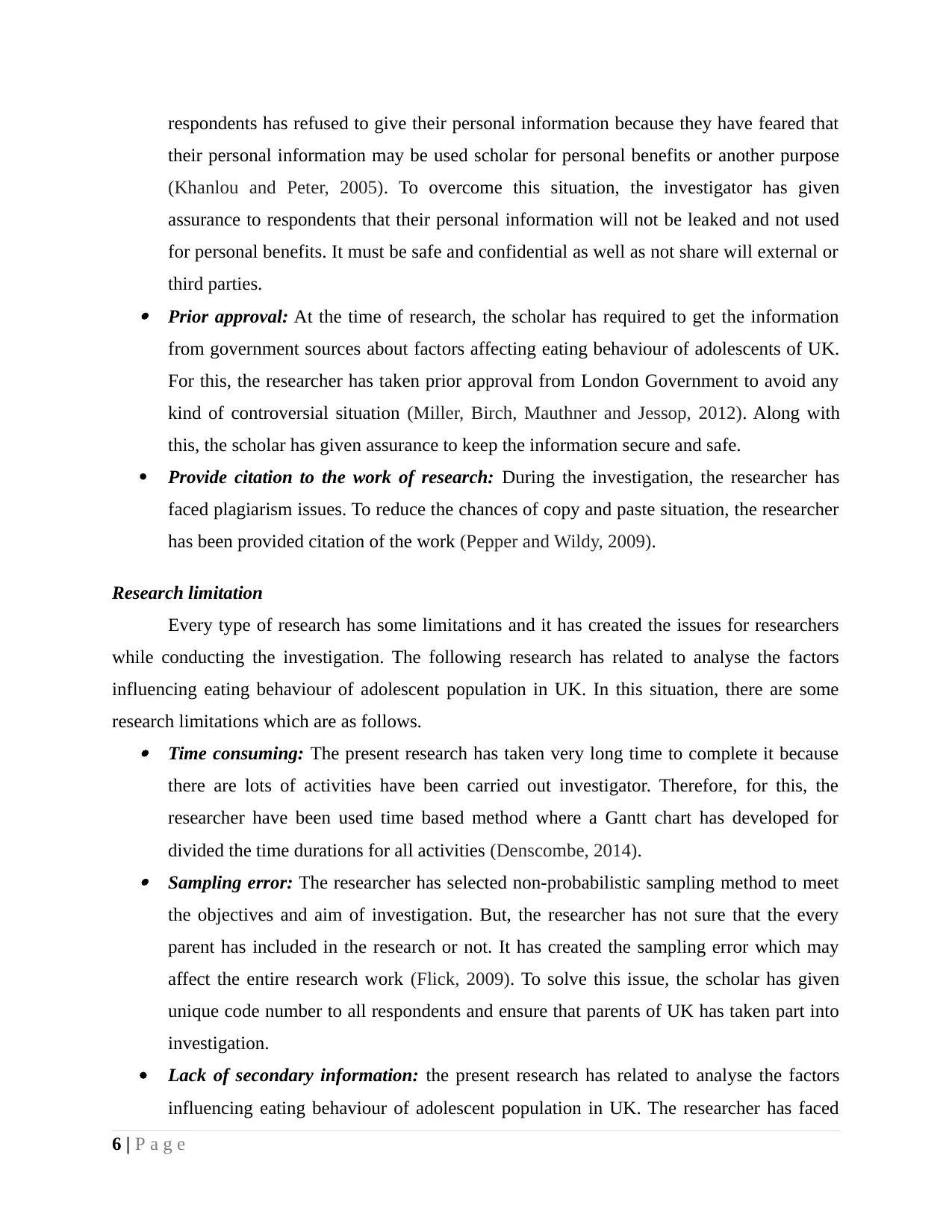
respondents has refused to give their personal information because they have feared that
their personal information may be used scholar for personal benefits or another purpose
(Khanlou and Peter, 2005). To overcome this situation, the investigator has given
assurance to respondents that their personal information will not be leaked and not used
for personal benefits. It must be safe and confidential as well as not share will external or
third parties. Prior approval: At the time of research, the scholar has required to get the information
from government sources about factors affecting eating behaviour of adolescents of UK.
For this, the researcher has taken prior approval from London Government to avoid any
kind of controversial situation (Miller, Birch, Mauthner and Jessop, 2012). Along with
this, the scholar has given assurance to keep the information secure and safe.
Provide citation to the work of research: During the investigation, the researcher has
faced plagiarism issues. To reduce the chances of copy and paste situation, the researcher
has been provided citation of the work (Pepper and Wildy, 2009).
Research limitation
Every type of research has some limitations and it has created the issues for researchers
while conducting the investigation. The following research has related to analyse the factors
influencing eating behaviour of adolescent population in UK. In this situation, there are some
research limitations which are as follows. Time consuming: The present research has taken very long time to complete it because
there are lots of activities have been carried out investigator. Therefore, for this, the
researcher have been used time based method where a Gantt chart has developed for
divided the time durations for all activities (Denscombe, 2014). Sampling error: The researcher has selected non-probabilistic sampling method to meet
the objectives and aim of investigation. But, the researcher has not sure that the every
parent has included in the research or not. It has created the sampling error which may
affect the entire research work (Flick, 2009). To solve this issue, the scholar has given
unique code number to all respondents and ensure that parents of UK has taken part into
investigation.
Lack of secondary information: the present research has related to analyse the factors
influencing eating behaviour of adolescent population in UK. The researcher has faced
6 | P a g e
their personal information may be used scholar for personal benefits or another purpose
(Khanlou and Peter, 2005). To overcome this situation, the investigator has given
assurance to respondents that their personal information will not be leaked and not used
for personal benefits. It must be safe and confidential as well as not share will external or
third parties. Prior approval: At the time of research, the scholar has required to get the information
from government sources about factors affecting eating behaviour of adolescents of UK.
For this, the researcher has taken prior approval from London Government to avoid any
kind of controversial situation (Miller, Birch, Mauthner and Jessop, 2012). Along with
this, the scholar has given assurance to keep the information secure and safe.
Provide citation to the work of research: During the investigation, the researcher has
faced plagiarism issues. To reduce the chances of copy and paste situation, the researcher
has been provided citation of the work (Pepper and Wildy, 2009).
Research limitation
Every type of research has some limitations and it has created the issues for researchers
while conducting the investigation. The following research has related to analyse the factors
influencing eating behaviour of adolescent population in UK. In this situation, there are some
research limitations which are as follows. Time consuming: The present research has taken very long time to complete it because
there are lots of activities have been carried out investigator. Therefore, for this, the
researcher have been used time based method where a Gantt chart has developed for
divided the time durations for all activities (Denscombe, 2014). Sampling error: The researcher has selected non-probabilistic sampling method to meet
the objectives and aim of investigation. But, the researcher has not sure that the every
parent has included in the research or not. It has created the sampling error which may
affect the entire research work (Flick, 2009). To solve this issue, the scholar has given
unique code number to all respondents and ensure that parents of UK has taken part into
investigation.
Lack of secondary information: the present research has related to analyse the factors
influencing eating behaviour of adolescent population in UK. The researcher has faced
6 | P a g e
⊘ This is a preview!⊘
Do you want full access?
Subscribe today to unlock all pages.

Trusted by 1+ million students worldwide
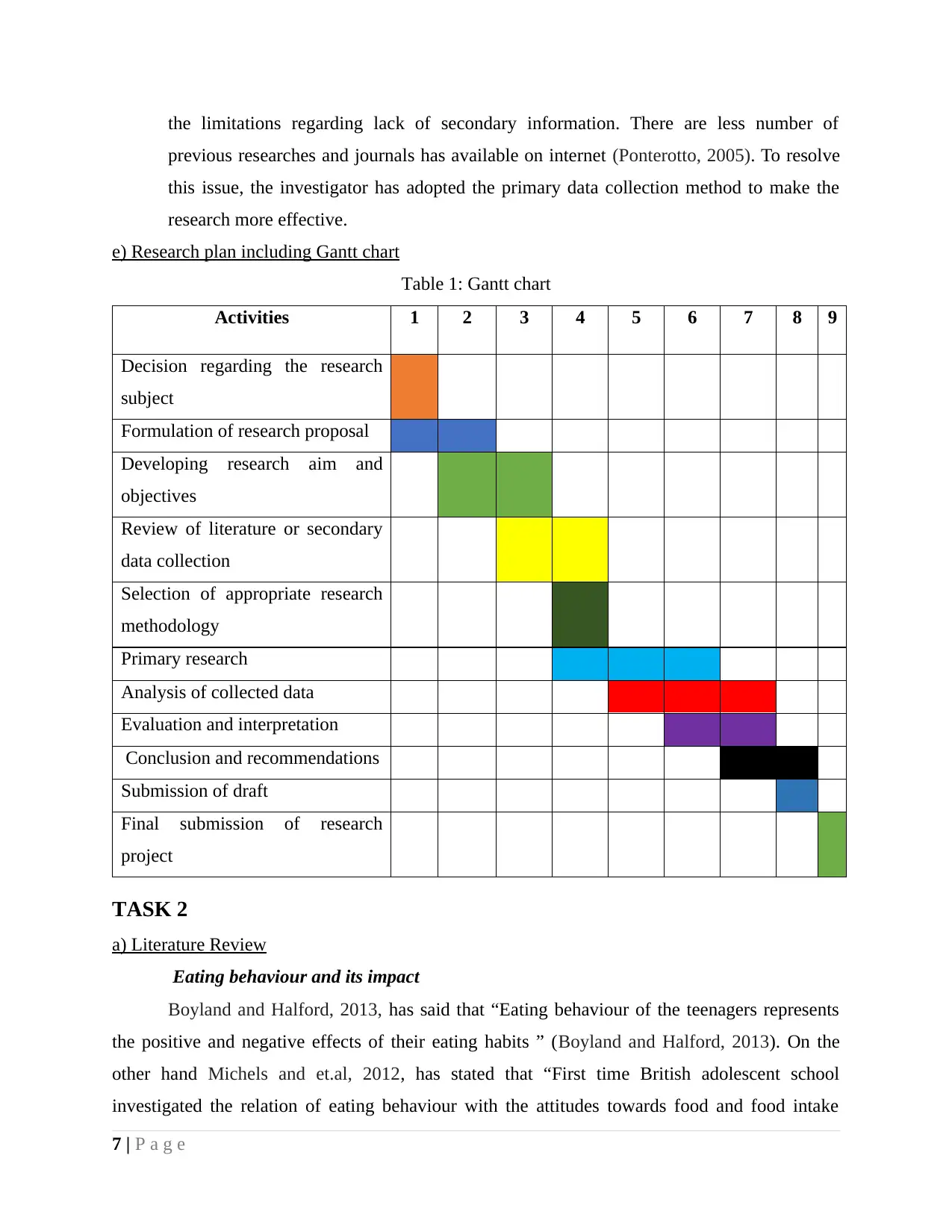
the limitations regarding lack of secondary information. There are less number of
previous researches and journals has available on internet (Ponterotto, 2005). To resolve
this issue, the investigator has adopted the primary data collection method to make the
research more effective.
e) Research plan including Gantt chart
Table 1: Gantt chart
Activities 1 2 3 4 5 6 7 8 9
Decision regarding the research
subject
Formulation of research proposal
Developing research aim and
objectives
Review of literature or secondary
data collection
Selection of appropriate research
methodology
Primary research
Analysis of collected data
Evaluation and interpretation
Conclusion and recommendations
Submission of draft
Final submission of research
project
TASK 2
a) Literature Review
Eating behaviour and its impact
Boyland and Halford, 2013, has said that “Eating behaviour of the teenagers represents
the positive and negative effects of their eating habits ” (Boyland and Halford, 2013). On the
other hand Michels and et.al, 2012, has stated that “First time British adolescent school
investigated the relation of eating behaviour with the attitudes towards food and food intake
7 | P a g e
previous researches and journals has available on internet (Ponterotto, 2005). To resolve
this issue, the investigator has adopted the primary data collection method to make the
research more effective.
e) Research plan including Gantt chart
Table 1: Gantt chart
Activities 1 2 3 4 5 6 7 8 9
Decision regarding the research
subject
Formulation of research proposal
Developing research aim and
objectives
Review of literature or secondary
data collection
Selection of appropriate research
methodology
Primary research
Analysis of collected data
Evaluation and interpretation
Conclusion and recommendations
Submission of draft
Final submission of research
project
TASK 2
a) Literature Review
Eating behaviour and its impact
Boyland and Halford, 2013, has said that “Eating behaviour of the teenagers represents
the positive and negative effects of their eating habits ” (Boyland and Halford, 2013). On the
other hand Michels and et.al, 2012, has stated that “First time British adolescent school
investigated the relation of eating behaviour with the attitudes towards food and food intake
7 | P a g e
Paraphrase This Document
Need a fresh take? Get an instant paraphrase of this document with our AI Paraphraser
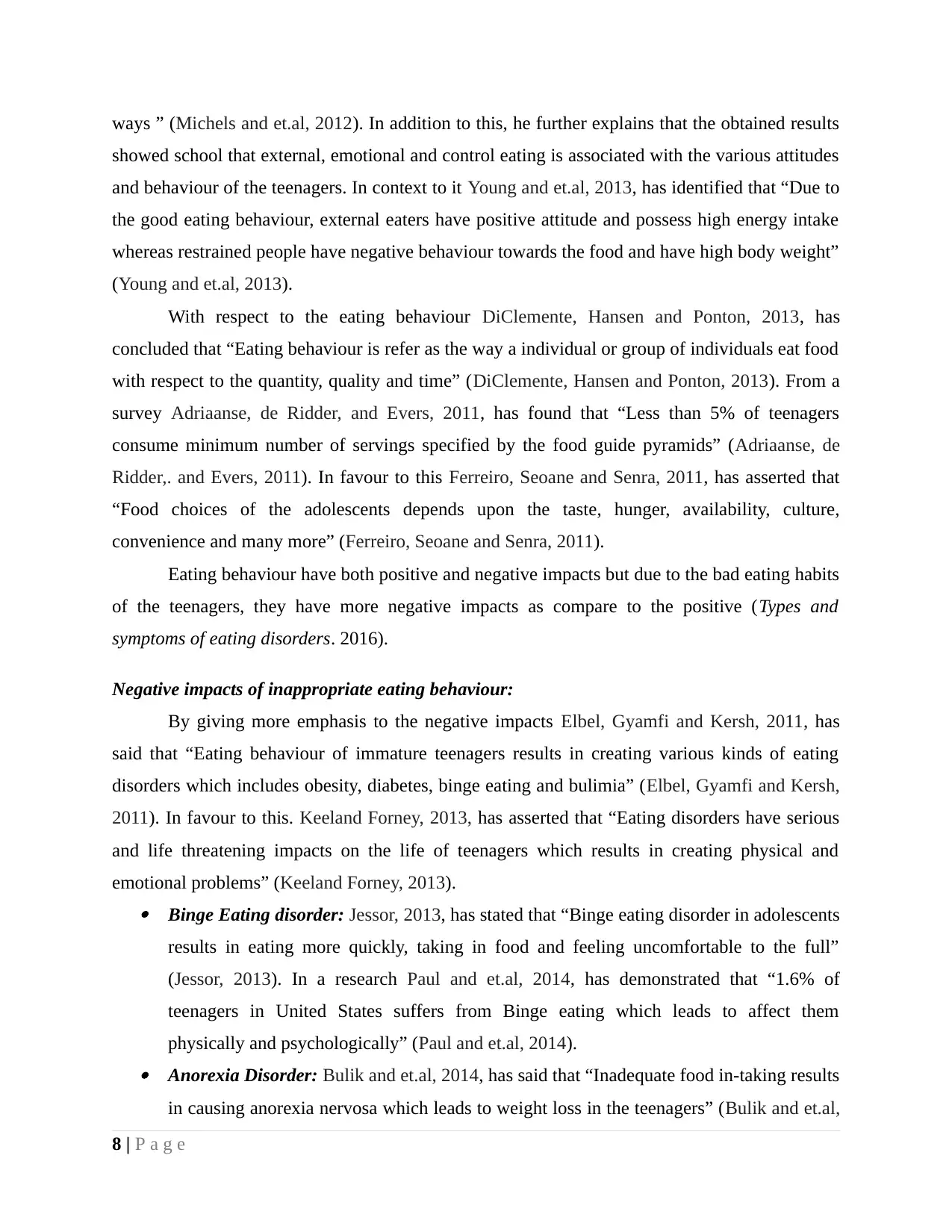
ways ” (Michels and et.al, 2012). In addition to this, he further explains that the obtained results
showed school that external, emotional and control eating is associated with the various attitudes
and behaviour of the teenagers. In context to it Young and et.al, 2013, has identified that “Due to
the good eating behaviour, external eaters have positive attitude and possess high energy intake
whereas restrained people have negative behaviour towards the food and have high body weight”
(Young and et.al, 2013).
With respect to the eating behaviour DiClemente, Hansen and Ponton, 2013, has
concluded that “Eating behaviour is refer as the way a individual or group of individuals eat food
with respect to the quantity, quality and time” (DiClemente, Hansen and Ponton, 2013). From a
survey Adriaanse, de Ridder, and Evers, 2011, has found that “Less than 5% of teenagers
consume minimum number of servings specified by the food guide pyramids” (Adriaanse, de
Ridder,. and Evers, 2011). In favour to this Ferreiro, Seoane and Senra, 2011, has asserted that
“Food choices of the adolescents depends upon the taste, hunger, availability, culture,
convenience and many more” (Ferreiro, Seoane and Senra, 2011).
Eating behaviour have both positive and negative impacts but due to the bad eating habits
of the teenagers, they have more negative impacts as compare to the positive (Types and
symptoms of eating disorders. 2016).
Negative impacts of inappropriate eating behaviour:
By giving more emphasis to the negative impacts Elbel, Gyamfi and Kersh, 2011, has
said that “Eating behaviour of immature teenagers results in creating various kinds of eating
disorders which includes obesity, diabetes, binge eating and bulimia” (Elbel, Gyamfi and Kersh,
2011). In favour to this. Keeland Forney, 2013, has asserted that “Eating disorders have serious
and life threatening impacts on the life of teenagers which results in creating physical and
emotional problems” (Keeland Forney, 2013). Binge Eating disorder: Jessor, 2013, has stated that “Binge eating disorder in adolescents
results in eating more quickly, taking in food and feeling uncomfortable to the full”
(Jessor, 2013). In a research Paul and et.al, 2014, has demonstrated that “1.6% of
teenagers in United States suffers from Binge eating which leads to affect them
physically and psychologically” (Paul and et.al, 2014). Anorexia Disorder: Bulik and et.al, 2014, has said that “Inadequate food in-taking results
in causing anorexia nervosa which leads to weight loss in the teenagers” (Bulik and et.al,
8 | P a g e
showed school that external, emotional and control eating is associated with the various attitudes
and behaviour of the teenagers. In context to it Young and et.al, 2013, has identified that “Due to
the good eating behaviour, external eaters have positive attitude and possess high energy intake
whereas restrained people have negative behaviour towards the food and have high body weight”
(Young and et.al, 2013).
With respect to the eating behaviour DiClemente, Hansen and Ponton, 2013, has
concluded that “Eating behaviour is refer as the way a individual or group of individuals eat food
with respect to the quantity, quality and time” (DiClemente, Hansen and Ponton, 2013). From a
survey Adriaanse, de Ridder, and Evers, 2011, has found that “Less than 5% of teenagers
consume minimum number of servings specified by the food guide pyramids” (Adriaanse, de
Ridder,. and Evers, 2011). In favour to this Ferreiro, Seoane and Senra, 2011, has asserted that
“Food choices of the adolescents depends upon the taste, hunger, availability, culture,
convenience and many more” (Ferreiro, Seoane and Senra, 2011).
Eating behaviour have both positive and negative impacts but due to the bad eating habits
of the teenagers, they have more negative impacts as compare to the positive (Types and
symptoms of eating disorders. 2016).
Negative impacts of inappropriate eating behaviour:
By giving more emphasis to the negative impacts Elbel, Gyamfi and Kersh, 2011, has
said that “Eating behaviour of immature teenagers results in creating various kinds of eating
disorders which includes obesity, diabetes, binge eating and bulimia” (Elbel, Gyamfi and Kersh,
2011). In favour to this. Keeland Forney, 2013, has asserted that “Eating disorders have serious
and life threatening impacts on the life of teenagers which results in creating physical and
emotional problems” (Keeland Forney, 2013). Binge Eating disorder: Jessor, 2013, has stated that “Binge eating disorder in adolescents
results in eating more quickly, taking in food and feeling uncomfortable to the full”
(Jessor, 2013). In a research Paul and et.al, 2014, has demonstrated that “1.6% of
teenagers in United States suffers from Binge eating which leads to affect them
physically and psychologically” (Paul and et.al, 2014). Anorexia Disorder: Bulik and et.al, 2014, has said that “Inadequate food in-taking results
in causing anorexia nervosa which leads to weight loss in the teenagers” (Bulik and et.al,
8 | P a g e

2014). In favour to this Rosen, 2013, has stated that “Anorexia Nervosa results to create
weakness and continuous muscle loss. Along with it, patient suffers from dehydration
which can lead to kidney failure” (Rosen, 2013)
Bulimia Nervosa: In a research Kaplan, and Garfinkel, 2013, found that “Approximate 1
to 2% of adolescents suffers from bulimia nervosa and from them mostly are
females”(Kaplan, and Garfinkel, 2013) With respect to this disorder Covey, 2011, has
concluded that “Bulimia nervosa results in serious depression and social changes which
creates risk of suicide” (Covey, 2011)
Positive impact of eating behaviour:
In a research van’t Riet and et.al, 2011, has identified that “Eating with parents can
impact positively on the health of the teenagers and results in proper eating behaviour” (van’t
Riet and et.al, 2011) In context to this Benowitz-Fredericks and et.al, 2012, has asserted that
“Proper food choices, place selection, etc helps in improving the eating behaviour of the today's
teenagers” (Benowitz-Fredericks and et.al, 2012). By giving more emphasis to the parents
Strasburger, 2011, has asserted that “Eating with parents improves the meal habits of adolescents
and makes them to enjoy their meal which directly affect their dietary quality” (Strasburger,
2011).
On the other hand Coates, Petersen and Perry, 2013, has suggested that “Proper meal
schedule under enjoyable and talkative environment results in healthy diet full. Along with it,
proper location of the meal such as dining room, kitchen also impacts positively on the health
and behaviour of the teenagers” (Coates, Petersen and Perry, 2013) In favour to this Boyland and
Halford, 2013, has said that “Parents plays important role in providing healthy diet and suitable
environment to their children for keeping them healthy and safe” (Boyland and Halford, 2013).
In oppose to the above Young and et.al, 2013, has said that “Type of food is more
important as compare to the presence of parents” (Young and et.al, 2013). In addition to this, he
further stated that quality and type of food eaten during the mealtime helps in determining the
positive or negative impact on the teenagers. In contrast to this Keeland Forney, 2013, has
demonstrated that “Eating same type of food but in the presence of parents impact more on the
health of the adolescents as it is related to the healthier diet and friendly surrounding” (Keeland
Forney, 2013). As per these statements, it is clear that presence of parents can improve the eating
behaviour of the teenagers which results in improving their mood, boosting their energy,
9 | P a g e
weakness and continuous muscle loss. Along with it, patient suffers from dehydration
which can lead to kidney failure” (Rosen, 2013)
Bulimia Nervosa: In a research Kaplan, and Garfinkel, 2013, found that “Approximate 1
to 2% of adolescents suffers from bulimia nervosa and from them mostly are
females”(Kaplan, and Garfinkel, 2013) With respect to this disorder Covey, 2011, has
concluded that “Bulimia nervosa results in serious depression and social changes which
creates risk of suicide” (Covey, 2011)
Positive impact of eating behaviour:
In a research van’t Riet and et.al, 2011, has identified that “Eating with parents can
impact positively on the health of the teenagers and results in proper eating behaviour” (van’t
Riet and et.al, 2011) In context to this Benowitz-Fredericks and et.al, 2012, has asserted that
“Proper food choices, place selection, etc helps in improving the eating behaviour of the today's
teenagers” (Benowitz-Fredericks and et.al, 2012). By giving more emphasis to the parents
Strasburger, 2011, has asserted that “Eating with parents improves the meal habits of adolescents
and makes them to enjoy their meal which directly affect their dietary quality” (Strasburger,
2011).
On the other hand Coates, Petersen and Perry, 2013, has suggested that “Proper meal
schedule under enjoyable and talkative environment results in healthy diet full. Along with it,
proper location of the meal such as dining room, kitchen also impacts positively on the health
and behaviour of the teenagers” (Coates, Petersen and Perry, 2013) In favour to this Boyland and
Halford, 2013, has said that “Parents plays important role in providing healthy diet and suitable
environment to their children for keeping them healthy and safe” (Boyland and Halford, 2013).
In oppose to the above Young and et.al, 2013, has said that “Type of food is more
important as compare to the presence of parents” (Young and et.al, 2013). In addition to this, he
further stated that quality and type of food eaten during the mealtime helps in determining the
positive or negative impact on the teenagers. In contrast to this Keeland Forney, 2013, has
demonstrated that “Eating same type of food but in the presence of parents impact more on the
health of the adolescents as it is related to the healthier diet and friendly surrounding” (Keeland
Forney, 2013). As per these statements, it is clear that presence of parents can improve the eating
behaviour of the teenagers which results in improving their mood, boosting their energy,
9 | P a g e
⊘ This is a preview!⊘
Do you want full access?
Subscribe today to unlock all pages.

Trusted by 1+ million students worldwide
1 out of 32
Related Documents
Your All-in-One AI-Powered Toolkit for Academic Success.
+13062052269
info@desklib.com
Available 24*7 on WhatsApp / Email
![[object Object]](/_next/static/media/star-bottom.7253800d.svg)
Unlock your academic potential
Copyright © 2020–2025 A2Z Services. All Rights Reserved. Developed and managed by ZUCOL.





